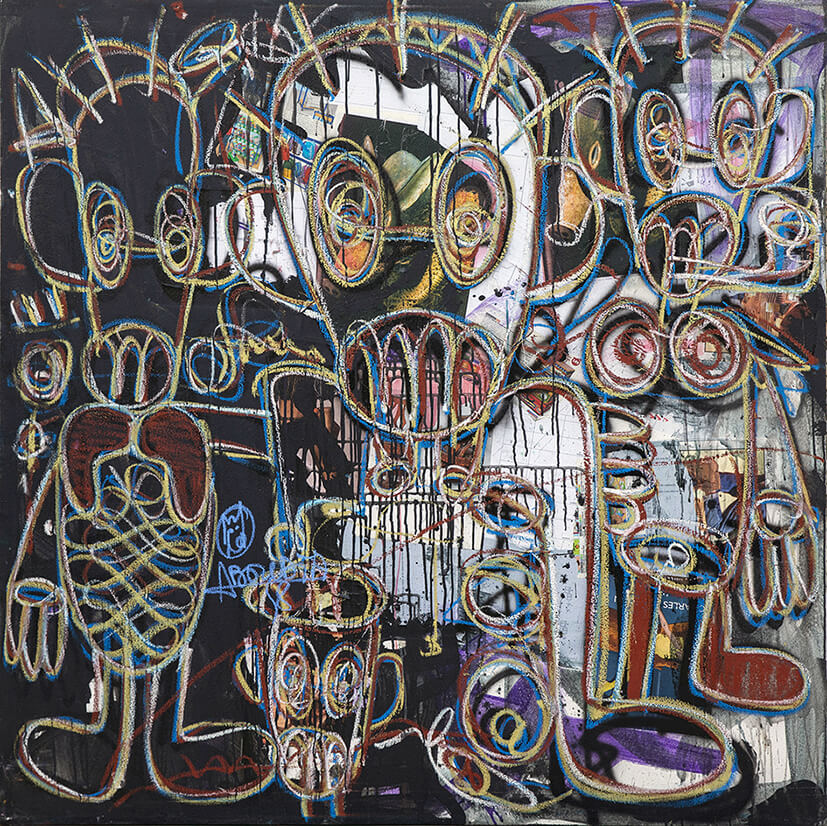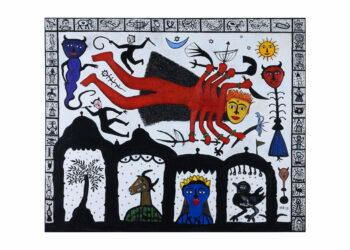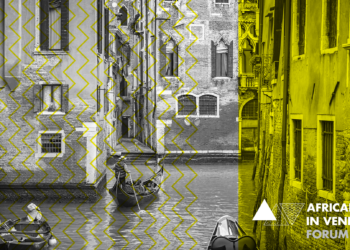Six artists will be presenting Côte d’Ivoire at the 59th Venice Biennale

Aboudia, La famille, 2021. Courtesy of the artist & the Pavilion Côte d’Ivoire.
At the 59th International Art Exhibition – La Biennale di Venezia, the Pavilion of the Côte d’Ivoire, located at Magazzino del Sale 3 (Dorsoduro, 264 – Zattere), is represented by six artists: Aboudia, Armand Boua, Frédéric Bruly Bouabré, Aron Demetz, Laetitia Ky, Yeanzi whose common intent is to highlight memories and dreams of a destiny to be built for a future that recognises the essential role of contemporary African culture. In this edition, the Pavilion enjoys the High Patronage of the First Lady of Côte d’Ivoire.
The Pavilion Commissioner is Henri Koffissé N’koumo, art critic and Director of plastic and visual art of Ministry of Culture and arts and entertainment industry of the Côte d’Ivoire, the curators are Alessandro Romanini, professor of theory of perception and psychology at the Academy of Fine Arts in Carrara and Massimo Scaringella, independent curator recognised for his exchanges with non-European countries.
Those who sleep, open themselves up to the realm of dreams. And it is precisely in dreams that images, myths and echoes of oral or written narratives are naturally recreated, of facts born from our own experiences, in particular our childhood, along with sublimations of our habitat… These dreams tell stories which, in Africa, often carry the value (and the validation) of spontaneous creation when one is looking to interpret and represent the socio-economic realities of the subject and of the collective. This reality, in turn, generates a concept highly characteristic of the creativity of Ivorian artists, in particular in the new generations’ capacity to merge, through art, traditions and innovations, memories and dreams of a destiny to be built in the contemporary art landscape. Art, in fact, is nothing more than the true intersection between dream and history. Between the subject who acts, who creates and who establishes themselves as the author, and their work, which becomes part of a shared heritage. And if this story has been denied to us, then we must dream about it.
Aboudia, born in Abidjan, Côte d’Ivoire, in 1983, lives and works between Abidjan and New York, conveys an African society torn in its social fabric, in which young people provide new lifeblood. Startlingly sharp images composed of contrasting faces, erotic nuances and newspaper clippings, in which today’s urban life emerges. Cars, skyscrapers, TVs, photographs and written phrases, resembling street art, bring to life a complex visual symphony whose rhythm is the rhythm of contemporary life.
Armand Boua, born in Abidjan, Côte d’Ivoire, in 1978, lives and works in Abidjan, portrays the human condition as a response to the inhumanity that dominates the world around him. His observations on children draw inspiration, for the most part, from street scenes in which urban migrations create a tangle of ethnic, linguistic, cultural and social threads.
Frédéric Bruly Bouabré, born in Abidjan, Côte d’Ivoire, in 1923 and died in Abidjan in 2014, is one of the founding fathers of contemporary African art, a singular figure whose creations represent religion and philosophy, tradition and legends. He is the inventor of an alphabet consisting of 448 monosyllabic pictograms, conceived with the desire to create a universal language which, rooted in the Beté tradition, would militate for universal brotherhood and world peace.
Aron Demetz, born in Vipiteno in Italy in 1972, lives and works in Val Gardena, interested in sculpture as an epistemological tool, turning his attention to non-Western plastic forms, in particular African ones. The artist explores the world through a parallel sculptural universe inhabited by fictional creatures and mysterious forms.
Laetitia Ky, born in Abidjan, Côte d’Ivoire, in 1996, lives and works in Abidjan, denounces the metamorphosis of bodies and the modern definitions of the contemporary human condition. The sculptures created by the artist with her Afro hair represent a powerful communication tool conceived to raise awareness on issues of race, gender and social justice, adapting elements from Ivorian customs and folklore. Elements of national identity, reinterpreted in a contemporary key.
Yeanzi, born in Katiola, Côte d’Ivoire, in 1988, lives and works in Bingerville (Côte d’Ivoire), reinterprets the biographical themes, the narrative and the recent history of his country, developing an iconography capable of transforming the experiences of the past into a powerful expressive form for the future. Through the materials chosen to create his works – in particular the use of waste and discarded items – the artist uncovers the incomparable beauty and aesthetics of the individual, thus questioning the mountains of waste suffocating today’s contemporary societies.



